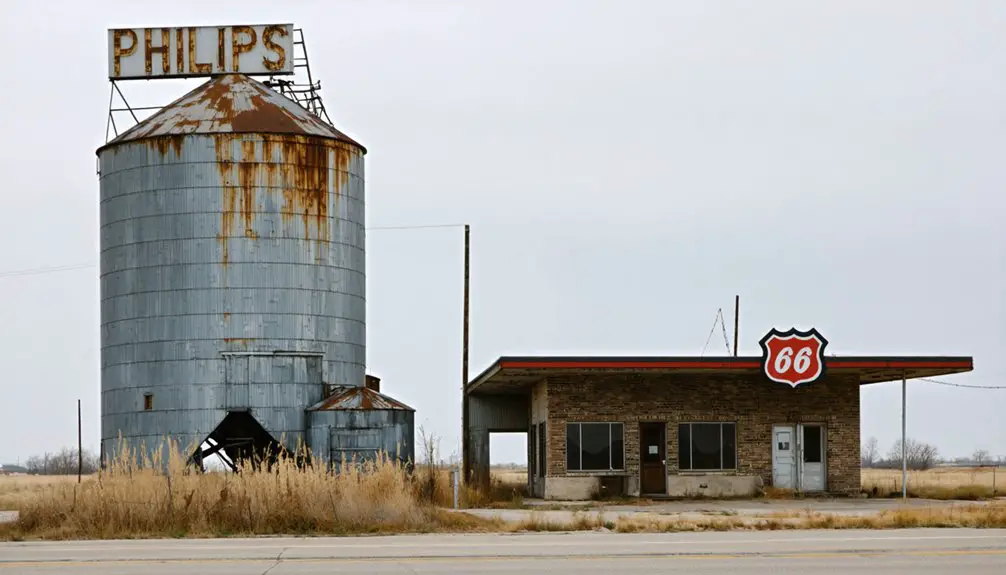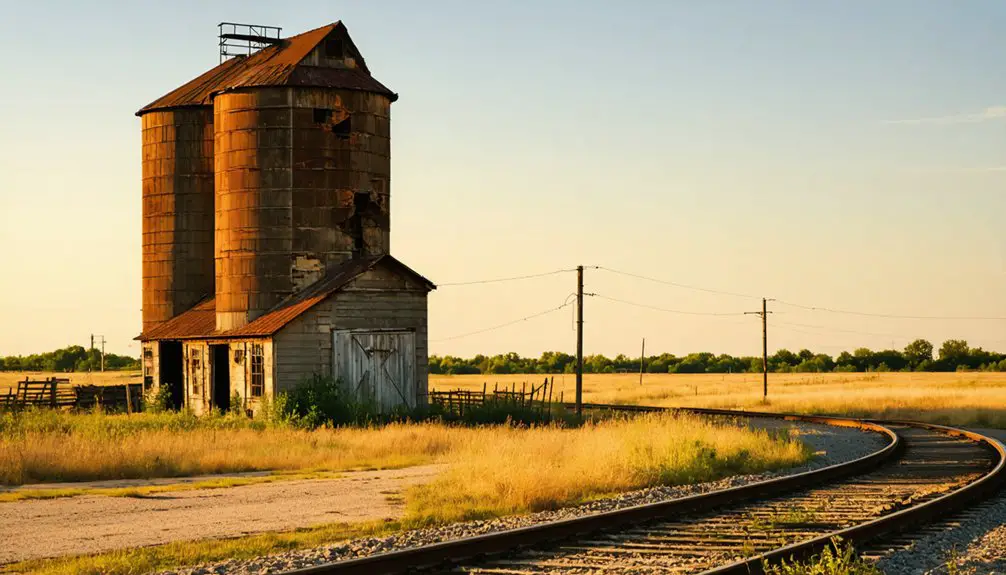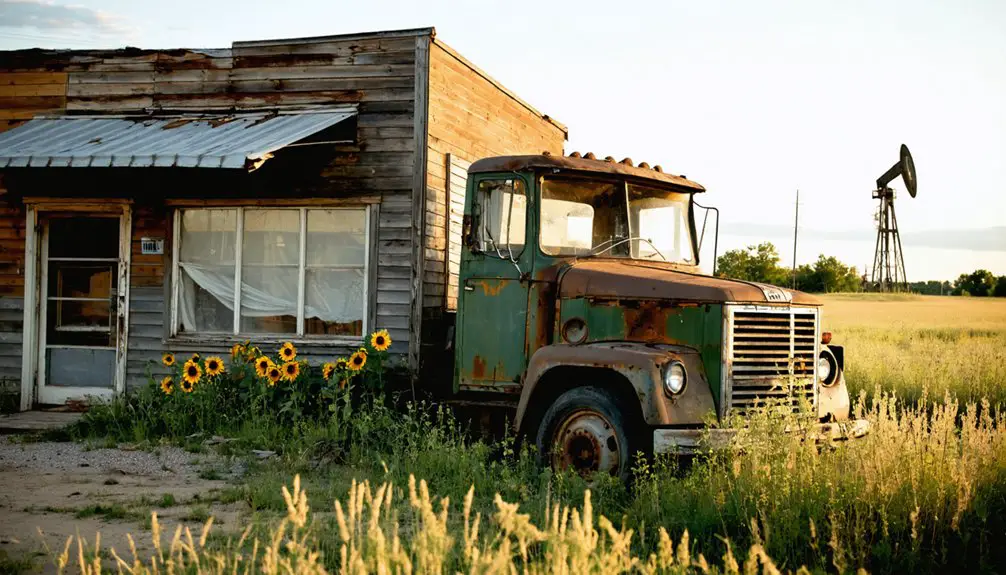You’ll find Alsuma’s ghost town remnants near present-day Tulsa, Oklahoma. Founded in 1905 as “Welcome,” this mixed-race settlement grew around the Missouri, Kansas and Texas Railroad station established in 1909. The town thrived with roughly 75 families until Tulsa’s industrial expansion in the 1960s led to its demise. While most physical traces have vanished beneath industrial parks, Alsuma’s unique story of racial coexistence in early 20th-century Oklahoma holds fascinating historical significance.
Key Takeaways
- Founded in 1905 as “Welcome,” Alsuma was a vibrant Oklahoma community with 75 families before becoming a ghost town.
- The Missouri, Kansas and Texas Railroad established Alsuma station in 1909, creating economic connections to larger cities.
- Closure of essential services, including the post office in 1926, initiated the town’s gradual decline.
- Tulsa’s 1966 annexation transformed Alsuma from residential to industrial, displacing approximately 75 families.
- Today, Alsuma exists only in memory, with its former townsite completely converted into industrial parks.
The Birth of a Rural Community
While many Oklahoma towns emerged organically around railroads and trading posts, Alsuma’s birth in 1905 reflected a unique confluence of cultural diversity and social compromise.
You’ll find the town’s very name embodies this spirit, derived from combining the first two letters of three girls’ names—Alice, Susan, and Maria—though some claim it honored a local merchant named John Alsuma.
Originally called Welcome, this 165-acre community quickly developed into a vibrant settlement where approximately 75 families established roots. The establishment of a U.S. Post Office marked the town’s official renaming to Alsuma. Most residents earned their living as farm and ranch hands in the surrounding agricultural areas.
From its modest beginnings as Welcome, Alsuma grew into a thriving community where dozens of pioneering families found their home.
African American, Native American, European, and Spanish descent residents built a self-sufficient economy through community gardening and local businesses.
Despite the era’s segregation, with the railroad physically dividing white and black neighborhoods, Alsuma fostered a culture of coexistence where commercial and community activities bridged racial boundaries.
Railroad’s Role in Town Development
When the Missouri, Kansas and Texas Railroad established its Alsuma station in 1909, it transformed this small Oklahoma settlement into an essential transportation hub. The railroad development physically divided the town, creating distinct neighborhoods separated by race, with Black families residing on one side and white families on the other.
You’ll find that the “Katy” line, as locals called it, provided crucial economic connections to larger cities like Tulsa and Broken Arrow. Following the Post-Civil War Treaty that introduced railroads to Indian Territory, the station transported coal, cattle, and grain, while giving residents access to broader markets and employment opportunities.
When officials attempted to rename it “Trovillion” in 1926, locals repeatedly stole the new signs, showing their deep attachment to Alsuma’s identity. The station’s closure in 1940 marked the end of direct rail service, though a secondary station operated until 1971.
Origins Behind the Name
Before adopting its distinctive name, the town operated under the simple designation of Welcome, Oklahoma, with its post office opening in 1905.
The community quickly sought a new identity to avoid confusion, and that’s when the name Alsuma emerged. While there’s debate about the exact name origins, the most compelling story involves three young women whose names created a lasting legacy.
- The name combines the first two letters of Alice, Susan, and Maria/Mary.
- This compromise brought together a diverse community of African, Native American, European, and Spanish families.
- The new community identity transcended racial tensions of the early 1900s.
You’ll find competing theories, including one about a merchant named John Alsuma, but the three-women story has become deeply woven into local lore, symbolizing unity and cooperation.
Life During Segregation
The Missouri, Kansas and Texas Railroad tracks carved a stark physical and social divide through Alsuma, separating black families from white residents during Oklahoma’s segregation era.
Railroads both connected and divided – cutting through communities and carving racial lines into the Oklahoma landscape.
While black families were among the area’s first landowners through Native tribal allotments after the Civil War, you’ll find their community resilience tested by systemic barriers.
Despite making up a significant portion of Alsuma’s 75 families, black residents faced limited economic opportunities, working primarily as farm hands for white landowners. The state’s Senate Bill One formalized these racial divisions in employment and social status.
Their cultural heritage endured even as the city denied them basic services after the 1966 annexation.
Children attended a segregated school that offered fewer resources than the white Union High School.
Educational Divide and Integration
You’d find stark contrasts between Alsuma’s separate school, which lacked basic amenities like running water and bathrooms, and the well-equipped Union School District that later absorbed its students.
This disparity reflected the broader reality that “separate but equal” facilities were anything but equal across the nation.
When integration was mandated in 1955, Alsuma’s separate school closed permanently, transferring all students to Union School District in a move that marked the end of the town’s segregated education system. The district implemented attendance zones that year to facilitate integration between black and white students.
While this change brought access to better facilities and resources, it also contributed to Alsuma’s decline as a community center, demonstrating how educational integration, though necessary, could alter the fabric of small Black communities.
Separate But Unequal Schools
During Oklahoma’s territorial and early statehood years, Alsuma’s schools reflected America’s deeply entrenched “separate but equal” doctrine, established by the 1896 Plessy v. Ferguson ruling.
Like many communities across the state, Alsuma’s educational system perpetuated stark racial inequities through segregated facilities that were anything but equal. This system was ultimately deemed inherently unequal by the Supreme Court.
- You’d find Black schools severely overcrowded, with one teacher often struggling to educate more than 60 students while white classrooms maintained manageable sizes of 25 pupils.
- You’d see Black teachers receiving lower wages despite working under more demanding conditions.
- You’d notice Black students using outdated, hand-me-down textbooks while white schools enjoyed new materials.
These educational disparities remained firmly in place until the landmark 1954 Brown v. Board of Education decision declared school segregation unconstitutional, though actual integration would face years of resistance. The groundbreaking research of Drs. Kenneth and Mamie Clark demonstrated the psychological harm of segregation on Black children, providing crucial evidence for the Supreme Court’s decision.
Integration’s Impact On Community
Landmark integration efforts in Alsuma during the mid-1950s dramatically reshaped the community’s social fabric, particularly in education.
You’ll find that the railroad tracks had long divided the town, with black families south and white families north, each maintaining separate schools and institutions that reinforced community cohesion within their respective areas.
When integration mandated black students transfer to Union High School, it triggered significant changes beyond just education.
The closure of Alsuma’s black school represented a form of cultural erasure, as this institution had served as a crucial gathering place and source of identity for black residents.
While integration aimed to provide equal educational opportunities, you’ll notice it simultaneously dissolved established social structures, contributing to demographic shifts that would eventually lead to Alsuma’s absorption into Tulsa by 1970.
Despite these challenges, the close-knit community maintained strong bonds through shared activities like fishing and playing football on neighborhood lawns.
The Peaceful Coexistence Story
Alsuma’s remarkable history of racial coexistence stands out among early 20th century Oklahoma settlements.
Despite the physical division created by the Katy railroad in 1909, this community demonstrated exceptional resilience through shared spaces and economic cooperation. Black and white residents maintained cultural diversity while working together in agriculture, commerce, and daily life.
- You’ll find evidence of unity in the town’s very name, created by combining letters from three women’s names – a symbol of compromise among community leaders.
- You’ll discover how churches served as neutral gathering spaces, fostering interracial connections despite segregation.
- You’ll see how the shared railroad station, post office, and local businesses created economic interdependence that transcended racial boundaries.
The town’s peaceful coexistence offers valuable lessons in community building and racial cooperation during challenging times.
Factors Leading to Abandonment

While the spirit of cooperation defined Alsuma’s early years, a complex web of economic and social factors would ultimately lead to the town’s decline.
You’ll find that the community’s fate was sealed by the loss of essential services, beginning with the post office’s closure in 1926 and the MKT railroad station’s shutdown in 1940.
The town’s social dynamics suffered as racial segregation divided the population, limiting growth and integration.
When Tulsa annexed Alsuma in the late 1960s, the conversion of its 165-acre townsite into an industrial park displaced families and erased the town’s residential character.
The absence of economic diversification, coupled with the loss of local institutions like schools and churches, accelerated the exodus of residents to larger urban centers.
Urban Growth and Industrial Transformation
You’ll find Alsuma’s transformation began in 1966 when Tulsa annexed the community, followed by a 1969 Urban Renewal plan that rezoned the 165-acre townsite from residential to industrial use.
The city’s expansion pushed out approximately 75 families as industrial parks replaced their homes, supported by newly extended water and sewer systems in 1971.
The development of major expressways – Broken Arrow and Mingo Valley – cemented Alsuma’s industrial future, turning the former residential community into what’s now known as the CNG Capital of the World.
City Expansion Drives Change
In 1966, Tulsa’s aggressive urban expansion absorbed the small community of Alsuma through annexation, marking the beginning of dramatic changes that would transform the area from a residential neighborhood into an industrial zone.
Despite community resilience, you’ll find that urban planning decisions systematically dismantled this mixed-race neighborhood through deliberate service denials and restrictive policies.
- Officials blocked new construction through a building moratorium, citing soil and septic concerns.
- The city withheld basic infrastructure improvements until after most residents had already left.
- By 1970, rezoning forced out approximately 75 families who’d called Alsuma home.
This calculated transformation turned a vibrant residential community into an industrial park, demonstrating how city expansion often sacrifices established neighborhoods for economic development.
Industrial Parks Replace Homes
After Tulsa’s 1970 rezoning mandate, industrial facilities rapidly replaced Alsuma’s residential heart, transforming the 165-acre townsite near 51st Street and Mingo Road into a sprawling industrial park.
You’ll find no trace today of the tight-knit community that once called Alsuma home. The city’s strategic industrial decline of residential services drove out approximately 75 families, including working-class and Black farmworker households who’d built their lives there. Former residents fondly remember lives without conflict between diverse communities.
Community displacement accelerated when Tulsa annexed the area in 1966, setting the stage for complete rezoning four years later. Adding insult to injury, you wouldn’t see city water and sewer services arrive until 1971, after most residents had already left.
Where family homes once stood, you’ll now find warehouses, industrial complexes, and stormwater management systems.
Preserving Alsuma’s Memory

While physical traces of Alsuma have largely disappeared beneath Tulsa’s industrial development, the town’s legacy lives on through oral histories and community documentation efforts.
Former residents share their memories through local historical societies and online platforms, ensuring memory preservation of their unique multi-racial community. Through community storytelling, they’ve documented the authentic experiences of life in this once-thriving railroad town.
- Personal narratives reveal details about daily life that official records missed, including shared experiences across racial lines despite segregation.
- Former residents gather periodically to share stories, keeping their community’s spirit alive for future generations.
- Historical documents and interviews capture the shift from farmland to industrial park, preserving Alsuma’s evolution in local history.
The Alsuma name endures in local landmarks like the Soccer Complex, maintaining its connection to Tulsa’s past.
Frequently Asked Questions
Were There Any Notable Crimes or Incidents in Alsuma’s History?
You won’t find notable crimes or violent incidents in available records. The town’s documented history shows social challenges from segregation rather than crime history or notable disruptive incidents.
What Types of Businesses and Stores Operated in Alsuma?
You’d have found essential businesses serving railroad travelers and locals, including a general store for daily goods and a feed mill supporting the agricultural community around the MKT station.
Did Any Famous People Come From or Visit Alsuma?
You won’t find any famous visitors or nationally recognized figures in Alsuma’s history. The town’s local legends were everyday working-class families, both Black and white, who made up this rural railroad community.
What Was the Average Property Value in Alsuma During Its Peak?
Penny wise, pound foolish – you can’t pinpoint exact property values, but given the town demographics of working-class families and rural setting, homes likely cost in the low hundreds during Alsuma’s early 1900s peak.
Were There Any Churches or Religious Organizations in the Community?
You’ll find multiple churches served Alsuma’s diverse community, with documented church history showing religious gatherings on both sides of the railroad tracks. One historic church still stands at 2443 North Peoria Avenue.
References
- https://en.wikipedia.org/wiki/Alsuma
- https://theokeagle.com/2019/09/12/alsuma-the-town-that-disappeared-from-southeast-tulsa/
- https://grownupgoonie.wordpress.com/2013/09/06/the-forgotten-town-of-alsuma/
- https://www.youtube.com/watch?v=5ADknCDv2Tw
- https://www.newson6.com/story/642e3b6ff1b14c7ae4b34f4f/alsuma:-the-ghost-town-inside-tulsa
- https://www.alsuma.me/history-of-alsuma-oklahoma
- https://rememberladies.weebly.com/uploads/1/2/5/1/125156519/276town_of_alsuma_1905-1970.pdf
- https://theokeagle.com/2023/04/06/alsuma-the-ghost-town-inside-tulsa/
- https://oklahomarailwaymuseum.org/wp-content/uploads/2023/03/A-Brief-History-Of-Oklahoma-Railroads.pdf
- https://tulsapreservationcommission.org/resources/tulsa-history/transportation/



